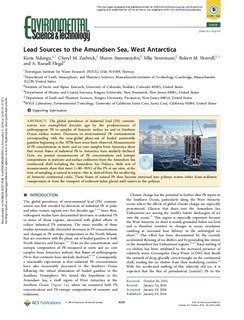| dc.contributor.author | Ndungu, Kuria | |
| dc.contributor.author | Zurbrick, Cheryl M | |
| dc.contributor.author | Stammerjohn, Sharon | |
| dc.contributor.author | Severmann, Silke | |
| dc.contributor.author | Sherrell, Robert M | |
| dc.contributor.author | Flegal, A. Russel | |
| dc.date.accessioned | 2018-11-12T07:39:50Z | |
| dc.date.available | 2018-11-12T07:39:50Z | |
| dc.date.created | 2017-02-17T11:08:03Z | |
| dc.date.issued | 2016 | |
| dc.identifier.citation | Environmental Science and Technology. 2016, 50 (12), 6233-6239. | nb_NO |
| dc.identifier.issn | 0013-936X | |
| dc.identifier.uri | http://hdl.handle.net/11250/2571906 | |
| dc.description | This is an open access article published under an ACS AuthorChoice License, which permits copying and redistribution of the article or any adaptations for non-commercial purposes. https://pubs.acs.org/page/policy/authorchoice_termsofuse.html | nb_NO |
| dc.description.abstract | The global prevalence of industrial lead (Pb) contamination was exemplified decades ago by the predominance of anthropogenic Pb in samples of Antarctic surface ice and in Southern Ocean surface waters. Decreases in environmental Pb contamination corresponding with the near-global phase-out of leaded automobile gasoline beginning in the 1970s have since been observed. Measurements of Pb concentration in snow and ice core samples from Antarctica show that recent fluxes of industrial Pb to Antarctica have similarly declined. Here, we present measurements of Pb concentrations and isotopic compositions in seawater and surface sediments from the Amundsen Sea continental shelf including the Amundsen Sea Polynya. Both sets of measurements show that most (∼60–95%) of the Pb at our sites, at the time of sampling, is natural in source: that is, derived from the weathering of Antarctic continental rocks. These fluxes of natural Pb then become entrained into polynya waters either from sediment resuspension or from the transport of sediment-laden glacial melt waters to the polynya. | nb_NO |
| dc.language.iso | eng | nb_NO |
| dc.publisher | American Chemical Society | nb_NO |
| dc.title | Lead Sources to the Amundsen Sea, West Antarctica | nb_NO |
| dc.title.alternative | Lead Sources to the Amundsen Sea, West Antarctica | nb_NO |
| dc.type | Journal article | nb_NO |
| dc.type | Peer reviewed | nb_NO |
| dc.description.version | publishedVersion | nb_NO |
| dc.rights.holder | © 2016 American Chemical Society | nb_NO |
| dc.source.pagenumber | 6233-6239 | nb_NO |
| dc.source.volume | 50 | nb_NO |
| dc.source.journal | Environmental Science and Technology | nb_NO |
| dc.source.issue | 12 | nb_NO |
| dc.identifier.doi | 10.1021/acs.est.5b05151 | |
| dc.identifier.cristin | 1451589 | |
| dc.relation.project | Andre: Swedish Polar Research Secretariat | nb_NO |
| dc.relation.project | Andre: NSF Office of Polar Programs: ANT-0838975 | nb_NO |
| dc.relation.project | Andre: NSF Office of Polar Programs: ANT-0838995 | nb_NO |
| dc.relation.project | Vetenskapsrådet: * | nb_NO |
| dc.relation.project | Andre: NSF Office of Polar Programs: OCE-1234213 | nb_NO |
| cristin.unitcode | 7464,30,21,0 | |
| cristin.unitname | Miljøkjemi | |
| cristin.ispublished | true | |
| cristin.fulltext | original | |
| cristin.qualitycode | 2 | |
